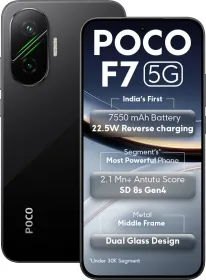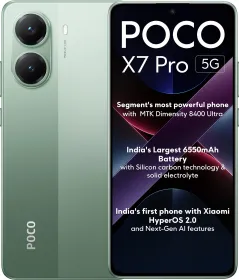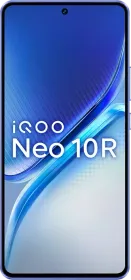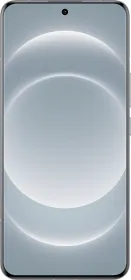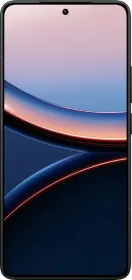POCO finally brought their value flagship product, the F7 to Global markets, including India, after much delay, and boy was it worth the wait. This new iteration brings in loads of upgrades over the outgoing in virtually all core areas. There is a new powerful SoC, better build quality and materials, IP rating, monstrous battery, and much more.
We have been using the POCO F7 as our daily driver for the past seven days. The phone undercuts its biggest competitor, the iQOO Neo 10, in terms of pricing in the characteristic POCO style. But does the POCO F7 have an actual advantage over the Neo 10? Let’s find out in our review.
POCO F7 Price & Availability
The POCO F7 is available in three color options – White, Black, and Cyber Silver. It is available in India in two configurations: 12GB + 256GB and 12GB + 512GB storage options.
- 12/256 GB: ₹31,999
- 12/512 GB: ₹33,999
The POCO F7 is available on Flipkart and select offline retailers.
Pros
- Premium build
- Bright and vibrant display
- Solid battery
- AI feature-rich
- Long software support
- IP68 rating
Cons
- Bloatware
- Cameras need polishing
- Thermal issues
POCO F7 Review: Specifications
- Display: 6.83” AMOLED, 120 Hz, 1600 Nits peak, 1272 x 2800 pixels, 450 PPI, Corning Gorilla Glass 7i
- SoC: Qualcomm Snapdragon 8s Gen 4
- RAM: 12 GB LPDDR5X RAM
- Storage: 256/512 GB UFS 4.1
- Cameras:
- Main: 50 MP Sony IMX882, 1/1.95-inch, f/1.8
- Ultrawide: 8MP 1/4-inch
- Front: 20 MP, f/2.0, 1/4-inch
- Speakers: Stereo
- Battery and charging: 7,550 mAh, 90W wired, reverse wired
- IP rating: IP68
- Biometrics: Under-display fingerprint scanner, 2D face unlock
- Weight: 222g
- Build: Glass back, metal frame
POCO F7 Review: Unboxing
The POCO F7 comes in a typical POCO cardboard box with clear branding on it. The cover features the phone’s name in bold text. Upon opening the box, the phone is revealed, looking quite premium. The phone boasts a metal & glass construction. Inside the box, you’ll find a Type-A to Type-C cable, an ultra-fast charger, a black silicone case, and some documentation.
POCO F7 Review: Design & Build
The design of the POCO F7 is, without a doubt, the biggest upgrade in the F series. While we have seen the brand opt for metal-glass sandwich design in the past, the recent models have all featured a plastic build. It’s where POCO’s commitment to being different in this price category is clearly on display.
Starting from the back, the F7 uses a metal build with a glass back to up the ante. The Corning Gorilla Glass 7i used here has this matte finish with a dual tone color on the White color we have in for you. The phone is undoubtedly much more premium-looking and feeling than last year’s Poco F6. Apart from this, White, the F7 also comes in a Black color and a special Cyber Silver color option.
The camera module has this oval design and features the dual-camera sensors, along with a neon-green inlay that may look like an LED to some unsuspecting buyers. The cameras are stacked onto an island which is not that much raised from the back, which allows the phone to not wobble much while placed on a flat surface.
The problem with making the phone look and feel premium and adding a proper 7,550mAh battery inside means that the POCO F7 is heavy. It tips the weighing scale at about 222g, which is higher than the competition. As for the button placement, the volume rockers and the power button are placed on the right side, keeping the left side clean.
The front of the phone is much more conventional. The 6.83-inch display is surrounded by slim, symmetrical bezels, giving it a modern look. The hole-punch selfie camera is centered at the top. The goodness just does not end here; the F7 also gets support for IP66, IP68, and IP69 ratings.
Overall, the design of the POCO F7 is a big step up from the F6. It’s undeniably different and deviates from the core POCO identity in a good way.
POCO F7 Review: Display
The POCO F7 sports a 6.83-inch flexible AMOLED display with a 120Hz refresh rate and 3840Hz PWM. The display specs are pretty much standard for this price range. Where the brand has done its magic is in the tuning. Colors are more vibrant, blacks are deep, and the 120Hz refresh rate makes scrolling and animations feel very smooth.
Brightness is adequate for the most part, hitting 1800 nits in HBM and peaking at 3200 nits. It’s perfectly usable outdoors, even in direct sunlight, although it might not be quite as dazzling as some of the top-tier flagships. The resolution is 1280 x 2772, with a 447 PPI providing sharp visuals. The panel is slightly taller and broader on the phone compared to its predecessor, with less rounded corners and Bezels that are slim and symmetrical.
The display is HDR10+ and Dolby Vision certified. This means it can display a wider range of colors and a higher dynamic range when watching compatible content. HDR videos on platforms like Netflix and YouTube will look more vibrant and lifelike, with greater detail in both the highlights and shadows.
There’s an in-display fingerprint sensor, which is fast and reliable. Overall, the display is a strong point for the F7. It’s not groundbreaking, but it covers all the basics. It’s more than good enough for everyday use, media consumption, and gaming.
POCO F7 Review: Speakers and Haptics
The POCO F7 boasts dual speakers – the earpiece doubles as one and another dedicated unit at the bottom – and they deliver impressive sound. Even at maximum volume, the audio remains clear, with distinct vocals and well-defined instruments. The sound separation is appreciable as well. The phone’s haptics are on the softer side and certainly need a bit of tuning, but they get the job done.
POCO F7 Review: Software
The POCO F7 relies on the goodness of HyperOS to stay afloat with all that crazy hardware. Some regions might have a ‘For POCO’ version of the HyperOS, but our unit comes with the latest HyperOS V2 built out of the box. This software is built on top of Android 15, and brings in familiar materials with the added advantage of customisation.
POCO adds a few unique touches, like their custom POCO launcher, custom icons, widgets, and more. The basics are still similar to what you would see on a Xiaomi or Redmi smartphone.



In a first instance, POCO is promising four years of Android version updates and six years of security updates, which is a big jump compared to the outgoing F6 model. It also helps F7 break into the software update game. This is good and goes head-to-head with the competition in this price band. Although not quite as generous as what Samsung and Google offer on some of their devices.
AI is the talk of the town, and every brand is coming up with its version of AI features apart from the standard ones being offered by Google. Sure enough, there’s Google Gemini, but you also get access to a whole lot of features under the Xiaomi HyperAI section. This section can be found in the settings for easy discovery and setup.
This Xiaomi HyperAI suite consists of features like AI Writing to help improve your writing skills, AI-powered Notes App, AI Gallery Editor that opens up access to features like Scene Expansion, Enhance, AI Erase, and much more.
Apart from this, HyperOS gets you tons of customisation, including blur effects in the control center and app drawer, themes, floating windows, split-screen, and more. Bloatware is still a problem on the F7, and it’s a tradeoff for getting the phone at cut-throat prices. Thankfully, most of it can be disabled, barring the stock apps. Your best bet to get a sound experience out of it would be to disable all the notifications from those apps.
In conclusion, the software experience is a highlight of the F7. It’s fast, fluid, and full of customization and features. There are still some areas where the brand can improve, and we hope that happens in the future.
POCO F7 Review: Performance
The POCO F7 comes powered by the freshly announced Qualcomm Snapdragon 8s Gen 4 chipset. Now, the 8s Gen 4 is a marginal upgrade over the 8s Gen 3, which we saw on the POCO F6 last year. The F7 comes with either 256GB or 512GB of fast UFS 4.1 storage, paired with 12GB LPDDR5X RAM. Unfortunately, there is no 16GB RAM option, which some of you might want, but the 12GB RAM does enough futureproofing.
In our daily use – browsing, social media, streaming video, and light gaming – the POCO F7 felt snappy and responsive. We did not experience any significant lag or slowdowns during our testing period. The phone handled games like Call of Duty: Mobile, Genshin Impact & BGMI at medium to high settings without any major issues.



Of course, this isn’t a flagship-level chip, but it does get you a taste of it. If you’re a hardcore gamer who demands the absolute highest frame rates and settings, the experience might not be the most optimal right now. But for the vast majority of users, the F7 packs enough punch.
In synthetic benchmarks, the F7 performs well, though it still trails some competitors. POCO claims an AnTuTu score of over 2,000,000 points, which we never achieved in our internal tests. The phone scored 1.9 million points on the AnTuTu V10 test, while Geekbench 6 scores were 2046 for single-core and 6545 for multi-core.
POCO F7 Review: Cameras
The POCO F7 comes with a fairly basic camera setup. At the back, you get a 50MP primary camera and an 8MP ultrawide lens. For selfies, it features a simple 20MP front camera. This setup closely resembles what we saw on last year’s POCO F6.
In terms of actual photo quality, the main 50MP camera does a pretty good job in well-lit environments. Pictures show nice colors and decent details. However, when you zoom into the images, you may notice some over-sharpening issues, causing the images to look somewhat unnatural. The camera also struggles a bit with contrast and dynamic range—highlights tend to be too bright, losing detail, and shadows can sometimes look overly dark.



The Poco F7 performs well when capturing portraits, both at regular (1x) and zoomed-in (2x) settings. It accurately identifies the subject and nicely blurs the background. However, skin tones often appear slightly darker than in real life, which could be improved.
As expected, photos from the 8MP ultrawide camera aren’t very sharp. They appear soft and lack detailed textures. Additionally, the ultrawide struggles with dynamic range and contrast, making images look flat and less vibrant.
Low-light photography is a strong point for the Poco F7’s main camera. Nighttime pictures retain plenty of detail, with minimal graininess. The camera also manages to capture well-balanced scenes, preserving highlights and shadow areas without overexposing bright spots.



Selfies captured with the 20MP front camera are average. While the detail is decent, the camera doesn’t reproduce skin tones accurately, and there’s noticeable graininess in the images. The dynamic range could use some improvement. On the upside, the selfie camera has a broad focus area, so your face remains in clear focus even if you’re not perfectly centered.
For video recording, the Poco F7 supports 4K resolution at 60 frames per second with its main camera. Meanwhile, the ultrawide and selfie cameras can record videos in Full HD resolution. Videos shot in 4K using the main camera look very good—sharp, detailed, and clean with excellent colors, contrast, and dynamic range. Even videos shot in low-light environments maintain good clarity, with little visible grain and well-balanced lighting.
POCO F7 Review: Battery Life and Charging
The POCO F7 excels in the battery department, packing a 7,550mAh battery. POCO managed to pack such a big cell due to shifting to the newer chemistry SiC battery. In our tests, we achieved a full day’s worth of use with heavy usage, with 40% battery still left, that could easily get us 6-8 hours of extra use. Users with less demanding usage patterns could expect upwards of two days of battery life on a single charge.
The F7 supports 90W fast charging technology, which is on par with the predecessor. With the supplied charger, you can charge the battery from 1 to 100% in less than 55 minutes, while it takes 20 odd minutes to fill up half the cell.
Verdict: Should You Buy the POCO F7?
The Poco F7 is exactly what we’ve come to expect from the F-series: a powerhouse built for speed. If you’re looking for a phone that feels incredibly fast, whether you’re swiping through apps or deep into a gaming session, the Snapdragon 8s Gen 4 chip inside delivers. Performance-wise, it’s a contender for the best value out there, though it can get a bit warm when pushed.
But the F7 isn’t a one-trick pony. It impresses on many other fronts. The screen is a standout—bright, with colors that look true to life. It feels more premium than its price suggests, thanks to a solid metal frame and an IP68 rating, which means it’s protected from dust and can handle a dunk in water. The HyperOS 2.0 software it runs on is also clean and reliable.
However, where the phone cuts corners is the camera. The main camera does a decent job when you have plenty of light. The secondary ultra-wide lens and the front-facing selfie camera are just average.
If your priority is raw performance, a great screen for watching videos, and a battery that lasts all day, all without breaking the bank, the POCO F7 should be your go-to choice. As for alternatives, you can look at the iQOO Neo 10 and the realme GT 7T.
First reviewed in July 2025.






















